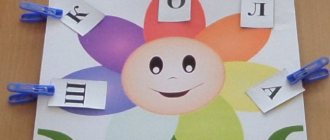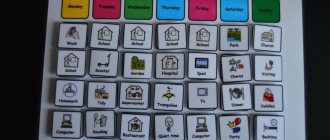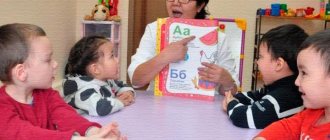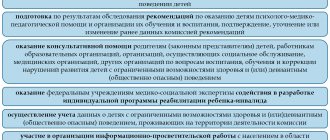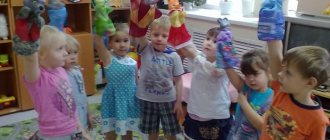Verbal games are an indispensable form of work with preschoolers, and not only in the educational field of “Speech development”. With their help, both educators and parents can easily and unobtrusively develop the intelligence and cognitive abilities of children, expand and clarify the little ones’ knowledge about nature, the objective world, and relationships in society.
- 2 Games with words without relying on visuals
- 3 Word games using pictures and objects
Word games in the middle group of kindergarten
Since the thinking of children of the fifth year of life moves from visual-actional to visual-figurative, that is, for better assimilation of information, children still need support from the image of objects, situations, purely verbal games, in which only words and actions are used, at this age they use less, than in senior preschool. But there are still easy word games, they quickly become understandable and loved by children. Such games are very convenient and popular because they can be used while walking, in transport, in line at a clinic or store to keep your fidget busy.
Word games can be a great way to communicate at home with your family.
Verbal games not only develop and educate the child, but also help to establish contact with adults and peers, teach the art of communication, and the ability to listen to the interlocutor.
Didactic game as a means of speech development in middle group children
A didactic game is one of the learning forms through which the teacher influences the child. Children play naturally and at ease, so they are ready to start a lesson at any time, either by coming up with a scenario on their own or following an interesting plot prepared by the teacher.
Note! With the help of such a game, the perception of educational material is an exciting process that stimulates performance and facilitates the perception of new things. During didactic entertainment, a preschooler’s psyche develops better and speech skills improve.
What are educational games aimed at?
During entertainment, which is aimed at labor education, the child begins to understand the importance and necessity of work, and to respect the end result of the activities of other people. Games that imply moral education are aimed at instilling cultural and hygienic skills, familiarization with relationships and feelings.
Games with words without relying on visuals
- “Say the opposite.” The adult invites the child to remember a word that is opposite in meaning to the one he himself named: “Small - big, long - short, high - low, etc.”
- “Call me kindly.” The child is asked to form the diminutive form of the noun: “Cat - cat, house - house, water - water.” Children who show increased interest in such a game can be offered a complicated version, in which they need to choose the diminutive form of the adjective: “Blue - blue, old - old, sweet - sweet.”
- “Which one, which one, which one?” The adult invites the child to come up with more words to describe an object or phenomenon: “What apple? (Red, round, smooth). What's winter like? (Cold, snowy). What kind of children are they? (Smart, cheerful, kind, obedient).”
- "It flies - it doesn't fly." Children need to listen carefully to the words being called and find the names of creatures or objects that can fly. If they are named, the children indicate them by clapping their hands or by saying “yes.” “Elephant, locomotive, plane (yes), cat, orange, butterfly (yes), table, sofa, helicopter (yes).” The games “Living - Inanimate”, “Edible - Inedible” are played in a similar way.
- “Find where it is.” The child is asked to look around carefully and find a bush, a door, a window, a flowerbed, a painting near him (depending on the location, the objects will be different), and point to them. In the first half of the school year, the teacher himself names the position of the object (far, close, left, behind). From the second half, the preschooler is offered to do this.
- “It happens - it doesn’t happen.” An adult recites a text that contains logical inconsistencies, and a child listens for errors. “Winter has come, flowers have bloomed, birds have sung. In autumn, the leaves on the trees turned green. In the summer, children build a snowman."
Many word games require active mental activity from the preschooler
- "Many and one." An adult names the plural of a noun, a preschooler must put it in the singular: “Many dolls - one doll, many bears - one bear, many clouds - one cloud.”
- “Yes and no.” The child needs to name what is in the forest, in the river, in kindergarten, in the city, etc., and what is not. “In the forest there are trees, animals, no houses, no cars.” The first two or three times the game can be played with hints: “Are there toys in the kindergarten? (Yes). What about forest animals? (No)". If children show a high interest in the game and are well oriented in the world around them, the game can be diversified with elements of fantasy, turn to the child’s favorite fairy tales, cartoons: “What is there in a magical land? In the world of Smeshariki, Fixies? Game option: “Where can we find it?” (Where can we find mushrooms? Toys? A cow? A piano?).
- “Finish the sentence.” The adult pronounces the beginning of the phrase, the child needs to logically complete it: “There’s... a car driving along the road. The bunny loves to eat... carrots. The birds flew away in the fall... to warmer climes.”
- “What will fit?” The child needs to name objects that will fit in the palm of his hand, the back of a car, a basket, or a room.
- "Necessary gifts." The adult names the objects, the child comes up with who can give them to (a hammer - to a builder, a craftsman, a rattle - to a baby, nuts - to a squirrel).
- "Good or bad". The presenter briefly describes the situation, the children determine whether the heroes did good or bad. “The boy helped the old lady carry her heavy bag home. Is it good or bad? The girl fell, and her friends laughed. Vitya ate a lot of sweets. Grandfather and grandson planted an apple tree.” At the beginning of familiarization with the game, the adult explains why the situation is good or bad; by the middle of the year, it is necessary to encourage children to make independent value judgments.
- "Our assistants." Children, together with an adult, answer the questions: “What can our hands do? (Take, draw, stroke, sculpt). Legs? (Run, jump, stomp), Eyes? (Look, blink, squint).” Game options: “Who is doing what?”, “Where we were - we won’t say what we did - we’ll show you”, in all of them you need to guess the action and name the verbs.
- “Guess by the description.” The child guesses the object based on the description of its signs and properties: “Round, rubber, rolling - a ball. Long, warm, knitted scarf.” From the second half of the school year, the adult and the child can change places: the child chooses an object, describes it, and the adult guesses. As an option, you can guess fairy tale characters, treats, toys, vegetables and fruits, that is, narrow the search field and make the task easier for your child.
- "Songs". Correct pronunciation of sounds is practiced in this simple game. An adult asks a question, the children need to reproduce the “song” clearly and correctly. “How does the cockerel crow? (Crow). What is the wolf's song? (Uh-uh-uh). How does a mother rock her baby? (Ah-ah). How does a hedgehog puff? (Pfft). Is the snake hissing? (Ssss).” When familiarizing yourself with the game, the “songs” are voiced by an adult.
In the game “Songs” it is necessary to monitor the correct articulation of the child’s lips
In the middle group, verbal didactic games are introduced (“Find out by description”, “Where does what grow?”, “Who does what”). Let's give an example of a game.
Didactic game “Guess who we made a guess about” (at the end of the year).
Didactic task: to activate the dictionary in the process of children compiling descriptions of well-known characters in the fairy tales “Kolobok” and “Teremok”.
Game rules: the guesser leaves the room, the teacher and the children agree on which animal and which riddle they will guess. The guesser is invited by a signal (reading book, poetry, etc.). In your answer you need to use the vocabulary of a fairy tale: mouse-norushka, bunny-runner.
Progress of the game.
1. The teacher invites the children to remember the characters of fairy tales that are well known to them (“Who met the bun? Who came running to the tower? What are they like? How can you say about a hare? a wolf? a bear? a fox? a mouse? a frog? a cockerel? What do they eat? How do they like to have fun ?).
Explains the rules of the game.
The one who guesses goes out the door. Everyone chooses a character together. The teacher invites everyone to think about what they will wish for the cockerel, and to remember what is said in the fairy tale about the cockerel.
The guesser enters. Children, together with the teacher, give a description of the cockerel (“Oil head, silk beard”; “Tail with patterns”; “Can fly”; “At dawn he sings cuckoo!”). The child guesses: “This is a cockerel - a golden comb.”
The game continues, other characters are described. (In repeated games, the teacher can give an example of a holistic description and invite the children to ask riddles one at a time.)
Thus, the complication of vocabulary work in the middle group is associated, first of all, with the expansion and deepening of knowledge about the world around us.
In this group, much attention is paid to enriching the vocabulary with words that give the child’s speech accuracy and expressiveness, help to express impressions and experiences: curly slender birch tree, sunny day, birch grove, spruce thicket, narrow path, green meadow, admiring a beautiful colored carpet, clearing.
Opportunities for working on the semantic side of a word are increasing. In the process of observations, examining objects, toys, paintings, attention is drawn to the word itself, children’s interest in the names of objects, their characteristics, and actions with them is encouraged. Children are given the task of choosing the most accurate word. Her decision is accompanied by explanations from the teacher, how best to say it. The etymology of motivated names is discussed (window sill - a board built under the window; what kind of utensils are called kitchen, dining, tea? Why?). Based on clarity, children select definitions (the bus is big, light, blue; the house is tall, big, brick), verbs (children run, play, draw; the rooster crows, sings; the kitten laps, meows, scratches), antonyms (cold - warm, clean - dirty, cheerful - sad.), synonyms (driver, chauffeur; cheerful, joyful; afraid - cowardly).
Gradually, the teacher begins to offer tasks for the selection of epithets, antonyms, synonymous series without visual material, in word games “What happens,” “Who can say more words about a doll, a ball,” “Name it affectionately,” “Say it differently,” “ I’ll start, and you continue,” “Add a word.” It is important that the material for these games be words related to different parts of speech, and most importantly, words that are well known to children (it is advisable to use those words that were worked on in the second younger group). In games of this kind, children develop their attention to words, linguistic flair, and the ability to choose the appropriate word in a certain phrase or sentence.
A greater place than in the previous group is occupied by work on polysemantic words. Children's attention continues to be drawn to ambiguous words; identify new meanings in words they already know (go, nose, leg, handle, etc.). In this case, a polysemantic word is highlighted with a voice (a pen on a doll; a pen on a door; a pen used to write). Children are asked to think about what, for example, the word goes: a boy is coming, a train is coming, time is passing.
To familiarize children with polysemantic words in the middle group, it is necessary to conduct special games and activities. On them, a polysemantic word becomes a semantic core, around which other words of a thematically related series are located. They use visual aids (objects, toys, pictures, drawings, photographs), as well as dramatization and staging. The classes are plot-based; they are united by one character - the doll Tanya. In a playful way, children learn to use the ambiguous word to stroke (kitten, dog, bunny, iron clothes). In subsequent lessons, they select antonyms for adjectives and verbs (the kitten ran away - Tanya is sad, sad, upset, cried, became sad; the kitten returned - Tanya cheered up, rejoiced, became cheerful) and come up with stories about Tanya, how she was sad at first, and then became cheerful. Children are taught to compose sentences and then stories with the ambiguous word pen, and are introduced to the different meanings of the word needle (for a hedgehog, a Christmas tree, a sewing needle). Experiments have shown that in the middle group, children begin to correlate words by meaning, think about which word is better to use, can explain their choice, and consciously use mastered words in coherent statements depending on their content.
Vocabulary games and exercises may contain tasks on the use of polysemantic words, synonyms, antonyms, phrases in coherent statements about objects and toys, pictures, as well as in statements on topics from personal experience.
In the fifth year, children become more attentive to artistic words. It is important to select figurative, vivid descriptions of objects and phenomena, texts that give rise to reflection on definitions, on the nuances of the meanings of words.
For example, K. Chukovsky’s riddle about a crane contains such vivid and imaginative descriptions and comparisons of objects that it can become the content of a conversation with children: “I am a giant: I instantly lift that huge, multi-pound slab, like a chocolate bar, to a height.” To explain the content of the riddle, one can use a selection of synonyms for words, a discussion of the difference in the words slab and tile, children inventing their own riddles about the faucet, etc. Nursery rhyme “Jumper” - “I leave the house and the steppe is beyond the threshold. I will rush across the steppe on a swift-footed horse. My wings are a daring horse. A bird on wings will soar over the steppe. The horse rushes across the steppe like a bird. My wings are a daring horse.” Questions “What is the name of the horse in the song? What else can you call it? How does a horse rush across the steppe? How can you say it differently?”, comparing a horse with a bird, thinking about the word wings will help children penetrate the figurative structure of speech.
Senior preschool age. A child of senior preschool age differs significantly from a child 4–5 years old. The most important thing is that his personality as a whole develops, his consciousness grows and develops. The child begins to think on the basis of general ideas, his attention becomes more focused and stable. The range of interests is expanding, activities are improving. On this basis, there is a further expansion and deepening of the range of ideas and growth of the vocabulary. Children aged 5 to 7 years old speak everyday vocabulary at the level of the spoken language of adults, use words not only with a general meaning, but also with an abstract meaning - grief, joy, courage. They develop a great interest in the word and its meaning. Word creation is also observed - in cases where the child’s vocabulary does not contain the required word (“self-shooting” pistol, “moonshine” machine). However, more often, in cases of difficulty, the child does not name the object. By the age of seven, the majority of words in a child’s vocabulary are nouns – about 42% and verbs – 43%. Adjectives and adverbs respectively occupy about 7% and 6%; function words – about 2%.
In the older group, it is necessary to expand the vocabulary through the names of objects, qualities, actions; activate the dictionary; learn to use the words that are most appropriate in meaning when denoting the characteristics and qualities of objects; to develop the ability to select words with opposite meanings (strong - weak, fast - slow, stand - run), with similar meanings (cheerful - joyful, jump - gallop, etc.); use words denoting material (wood, metal, glass, plastic, etc.); learn to comprehend figurative expressions in riddles, explain the meaning of sayings.
In the preschool group, attention is paid to working on the semantic side of the word, to children’s mastery of the expressive means of language.
At an older age, classes continue to enrich children's vocabulary. Direct perception of the surrounding world during excursions; observations, examination of objects, examination of paintings and other visual methods continue to occupy a leading place. The complication consists in expanding the range of objects with which children are introduced, in increasing the set of objects and materials, and their characteristics. One of the basic rules for introducing new words into a child’s vocabulary is to introduce the word in a certain context (the minimum context is a phrase or sentence).
Inspections of the premises are still being carried out, but this time of the entire kindergarten (“What rooms are there in the kindergarten? What is the name of the room we are in now? How many doors open into the corridor? Where does this door lead?”, etc.). Children remember what they observed before (“Where do we go if we leave the group room? What if we turn left?”).
Excursions outside the kindergarten, into nature, occupy a large place. Their content becomes more complex, more new words are given. During the excursions, children acquire knowledge about their hometown, about the street where the kindergarten is located, about the post office, school, library, get acquainted with the work of adults and at the same time master and clarify a variety of vocabulary: names of professions, equipment, labor processes.
The child’s ideas about seasonal changes in nature, about some animals and plants are expanded and clarified, and in this regard, natural history vocabulary is mastered.
Viewing objects and living objects also becomes more difficult. Particular attention is paid to enriching children's speech with adjectives and verbs that express the qualities and actions of observed objects. Thus, when examining a rabbit, one is not limited to such definitions of wool as white, soft, but seeks new expressive characteristics: warm, smooth, fluffy, silky. The verbs used are: jumps, gallops, crouches, chews, sniffs, crunches (carrots). A comparison is made of the object being observed at the moment with the one that was considered before, and a description of them is given.
Simultaneously with the deepening of knowledge, words are mastered that more accurately characterize the various characteristics of objects and actions. If in the second junior and middle groups, when looking at a picture, children denoted the movements of a hare, horse, fox with the verb runs, now when looking at the same pictures they use the following words: hare - gallops, runs, rushes, rushes; horse - runs, gallops; fox - runs, sneaks, chases.
Children's speech is enriched with adjectives that denote a larger number of features with a more subtle distinction (shades of color, condition of objects, differences in size, shape, etc.). The dictionary also introduces adverbs that characterize the qualities of actions: the chicken hastily pecks the grains; the clouds float slowly; The music sounds cheerful. The assimilation of adverbs is easier than adjectives, since, firstly, they do not have lexical homonymy, and secondly, in phrases and sentences they are adjacent to verbs, while adjectives agree with nouns.
In older preschool age, they continue to form a vocabulary that characterizes the qualities and properties of objects and materials. The complication of classes occurs due to the identification of a larger number of qualities and properties. Thus, children examine and compare different types of paper, fabric, things made of glass and earthenware, colored glass, metal and wood, plastic, consolidate and deepen the meanings of already known words, and learn new words.
Only in senior and preparatory school groups is it recommended to conduct independent studies comparing subjects. Their goal is to develop the ability to most accurately select words to describe objects. Methodological requirements for classes of this kind: 1) objects for comparison are selected in such a way that there is a sufficient number of compared characteristics (color, shape, size, parts, details, material, purpose, etc.); 2) the comparison must be planned, consistent - from comparing objects as a whole to isolating and comparing parts and then to generalization; 3) the main teaching methods should be questions and instructions that help children consistently compare, notice features that they themselves do not see, accurately formulate an answer and select the right word; 4) children should show maximum speech activity.
Classes are conducted on the formation of generic concepts based on generalization of groups of objects of various types. For classes, objects (pictures) of several similar types are selected, both included and not included in this concept. For example, to master the general word transport, they take pictures depicting not only vehicles, but also a combine, a cannon, a sewing machine, etc. First, children examine and describe pictures depicting transport (1st part of the lesson), then compare them and identify the common one a sign on the basis of which a generalization is made (carry, transport) and a generalizing word is introduced (2nd part), and, finally, exercises are carried out to select from different pictures those that relate to transport (summarizing the concept) (3rd part ). Similar work is being done with other generic concepts. Next comes their differentiation: clothing - summer, winter, demi-season, birds - wintering, migratory; transport – air, water, land, underground.
Thus, on the basis of examining, examining, comparing and generalizing objects, children gradually develop the conceptual nature of words.
Only in senior and preparatory school groups is it recommended to conduct independent studies comparing subjects. Their goal is to develop the ability to most accurately select words to describe objects. Methodological requirements for classes of this kind: 1) objects for comparison are selected in such a way that there is a sufficient number of compared characteristics (color, shape, size, parts, details, material, purpose, etc.); 2) the comparison must be planned, consistent - from comparing objects as a whole to isolating and comparing parts and then to generalization; 3) the main teaching methods should be questions and instructions that help children consistently compare, notice features that they themselves do not see, accurately formulate an answer and select the right word; 4) children should show maximum speech activity.
Classes are conducted on the formation of generic concepts based on generalization of groups of objects of various types. For classes, objects (pictures) of several similar types are selected, both included and not included in this concept. For example, to master the general word transport, they take pictures depicting not only vehicles, but also a combine, a cannon, a sewing machine, etc. First, children examine and describe pictures depicting transport (1st part of the lesson), then compare them and identify the common one a sign on the basis of which a generalization is made (carry, transport) and a generalizing word is introduced (2nd part), and, finally, exercises are carried out to select from different pictures those that relate to transport (summarizing the concept) (3rd part ). Similar work is being done with other generic concepts. Next comes their differentiation: clothing - summer, winter, demi-season, birds - wintering, migratory; transport – air, water, land, underground.
Thus, on the basis of examining, examining, comparing and generalizing objects, children gradually develop the conceptual nature of words.
In games and game exercises for selecting words, nouns, verbs, and adjectives are activated. For example, children are asked questions: “What can you sew? darn? try it on? push? button up? belt it? tie it? put on? In response, they must name the appropriate items. For each correct answer, children receive a chip. The one who collects the most chips wins.
A similar problem is solved in the game “Name Which One”. Children select definitions for the named item (scarf - warm, light, long, short, narrow, wide, knitted, beautiful).
2. classification of objects and their generalization:
· various types of classification of objects and their verbal designations according to different criteria (distribution of words into groups: vegetables, dishes, plants), according to generic and subgeneric characteristics: transport - railway, road, air, water, machines - agricultural, household, military;
· exclusion from a given group of objects and words that do not have a common characteristic (table, chair, sofa, glass, bed, chair, dress - “Which objects (words) are superfluous?”);
· selection of words with a specific meaning for a word denoting a generic concept (what fruits grow in the garden?; name the migratory birds; what products are sold in the grocery store?);
· subsuming words of specific meaning under the generic name (shoes, boots, sandals; beret, Panama, hat);
· generalization through opposition (a swallow is a bird, and a butterfly? A dress is clothes, and shoes?);
· composing phrases and sentences with words denoting specific and generic concepts.
Particular attention is paid to the semantization of vocabulary (revealing the semantic side of the word).
Explanation of the meanings of words is possible not only by relying on clarity, but also through already acquired words. The following methods of interpreting the meanings of words have found widespread use in practice:
· explanation of the meanings of words by showing pictures, for example, the phrase late autumn is explained in the process of showing pictures reflecting the state of nature in autumn;
· comparing a word with other words – put on – what?; dress – who?;
· explanation of the etymology of the word. For example, in stories for children of this age the following words are found: fieldfare thrushes, leaf-falling hares, fox mice in winter, half-winter November, marsh heron. Their explanation is given through word-formation analysis;
· composing phrases and sentences with the word being explained;
· explanation of the word with another word close in meaning: kaluzhinka - puddle, courageous - brave;
· selection of a word with the opposite meaning (antonym): slob - clean, neat, neat;
· explanation of the meaning of the word through its definition: a hero is a person distinguished by courage and performing feats; birch forest - birch forest;
· comparison of words by sound and meaning, selection of rhyming words.
The semantic side of speech also develops in the process of working on antonyms. First, techniques for working with isolated words are used, then with the same words in sentences and coherent statements:
· selection of an antonym for a given word: quiet -..., difficult -...;
· finding antonyms in stories, proverbs, sayings: “A thin wolf walked near a village and met a fat dog” (from a story by L.N. Tolstoy); “Prepare the sleigh in the summer and the cart in the winter”; “Work feeds, but laziness spoils”;
· finishing sentences with antonyms: It’s hot in summer, and in winter (cold, icy, frosty); All the people rejoiced in the spring, but the Snow Maiden (was sad, sad);
· composing sentences and coherent statements with a given pair of antonyms (smart - stupid, fun - boring).
Great opportunities open up in senior and preparatory school groups for working on synonyms. Words that are similar in meaning characterize different aspects of objects. An expert on the Russian word, L. V. Uspensky, advised parents and teachers from “an early age to develop in the child the ability to use synonyms. Teach him to play similar words: you name the word run, and let him choose three (five) synonyms for you: rush, rush, scoot, run away, run. He’ll pick it up, and you’ll sort it out with him: what’s successful, what’s not, and why exactly.”
Already in this recommendation we can highlight the following techniques for working with synonyms:
· selection of synonyms for an isolated word;
· explanation of the choice of words in a synonymous series.
In addition, it is also advisable to use the following techniques:
c) replacing a synonym in a sentence, discussing variant meanings: “The little gray bunny got cold, burst into tears” (wept, burst into tears, shed tears), “A small stream is running” (flowing, babbling, pouring);
· composing sentences with synonymous words;
· composing a story with synonymous words.
At this age stage, work with polysemantic words should continue. Here we can recommend:
· explanation and comparison of the meanings of polysemantic words in context: child’s (bunny’s) ear, needle’s eye; “The donkey is black, white-faced, the donkey has ears on the top of its head,” “The sun pulled the sleeping grain by the ear into the sun - and it rose”; “Stomp, stomp your feet, new boots”; “I am a drop of summer on a thin leg” - in a poem about strawberries; “Antoshka stands on one leg, whoever sees him, everyone will bow to him”;
· selection of words close in meaning to each meaning of a polysemantic word: hot pepper - bitter, hot; sharp needle - prickly, pointed (stick);
· selection of antonyms for each meaning of a polysemantic word: sharp - sweet (sugar), sharp - dull (needle), etc.
Effective techniques are also
· writing sentences with ambiguous words;
· drawing on the theme of a polysemantic word;
· finding polysemantic words in proverbs, sayings, riddles, tongue twisters and in literary works - fairy tales, poems, stories;
· inventing stories and fairy tales on the topic of polysemantic words.
All aspects of working on the semantic side of a word are interconnected and intertwined. The techniques mentioned above are used in games and game exercises such as “Who can come up with the most words?” (on a given topic, by attribute, by word), “Say the opposite,” “Say it differently,” in games of confusion and fables, etc. They are also described in a number of collections of didactic games.
Examples of games:
"Come up with a rhyme."
Didactic tasks: activate children's vocabulary with rhyming words; cultivate a sense of euphony in the native language.
Game rules: players are divided into two teams. You need to name as many words as possible that sound similar. You cannot repeat the spoken word. The team that names the most rhyming words (receiving more chips) wins.
Game actions. The leader names the words, the teams take turns continuing a series of rhyming words. The team that named the most words gets a chip. The game ends with a sound signal.
An approximate set of words: bird, nightingale, well done, frog, etc.
"Forbidden words."
Didactic task: to teach children to arbitrarily and consciously choose appropriate words in a sentence.
Game rule: make sentences without using “forbidden words.”
Progress of the game: children are invited to answer the teacher’s questions with a sentence, without using “forbidden words” (the most common). The one who comes up with the most sentences without “forbidden words” wins.
What is the kitten doing? (prohibited words: kitten, playing).
What does the bunny like? (prohibited words: bunny, carrot).
What fox? (prohibited words: fox, cunning).
What is the dog doing? (prohibited words: dog, barks).
What winter? (prohibited words: winter, cold).
Children are especially fond of the folk games “Fanta”, “Flowers”, “And We”, “Who Flies”, etc. For example, let’s take the game “And We”.
Children, listening to the presenter’s story, should after each phrase, taking into account its meaning, add or not add “And we.” For example:
I lived in the country in the summer. - And we.
It’s nice in the morning, the sun is warming, everything is quiet. – (“And we” – does not fit.)
The birds sing merrily. - And we.
Bug is lying at the porch.
The teacher needs to come up with and write down a story in advance so that its content is simple and entertaining. Children love this game for the fun moments that arise along the way.
In older preschool age, evaluative vocabulary is actively mastered. This is due to the formation of non-situational-personal communication between a child and an adult, and the manifestation of interest in the adult’s personality. Children begin to use words denoting personal characteristics (honest, modest, caring, sensitive, etc.). The teacher specially organizes work on this category of words in the interests of the moral and speech development of children. Moreover, adjectives are taken first, and on their basis - nouns (honesty, modesty, sensitivity, caring), since the meanings of the first are more specific than the meanings of the second. A guideline for selecting such words can be dictionaries (thesauruses) of the most common personality traits. Thus, the most frequent words are kind, honest, truthful, calm, sociable, lazy, indifferent, cunning, smart, modest, boastful. Of great importance for mastering emotional and evaluative vocabulary is the analysis of the actions of literary characters, their experiences and mood.
Let us give as an example the teacher’s questions on the content of literary works, aimed at clarifying children’s understanding of adjectives with ethical meaning. The first work was read for the first time, the second is well known to the children.
Questions about V. Oseeva’s fairy tale “The Hare’s Hat”: What is the name of the hare in the fairy tale? (Boastful, boastful.) Why was he called that? (He boasted: “I can jump over a pine tree,” etc.) Why was the hunter’s son called a braggart when he put on a hare’s hat? What did your friends name the girl? (“What a braggart”) What can you call a hare, a boy and a girl if they brag? What are they? Do you like braggarts? How do people feel about them? What can you call people who are not boastful? (Modest.)
Questions about “The Story of an Unknown Hero” by S. Marshak: What can you call this unknown hero? What is he like? (modest). What other words can you call an unknown hero? (brave, courageous, true hero),
In conclusion, the conclusion is drawn: immodest, boastful people are not liked, but modest people are respected. A humble person does not brag about his good deeds and deeds. No wonder people say: “modesty adorns a hero”; “Modesty suits everyone.”
Observations show that children rarely use phraseological units in communication. The figurative speech of surrounding adults and the artistic word are used as means of enriching children’s speech with phraseological units. In conversations on the content of literary works and folklore works of different genres, one should pay attention to figurative expressions and encourage children to use them in active speech.
Proverbs and sayings are excellent material in this regard. It is important that the meaning of proverbs and sayings is explained to children in connection with life situations. A common mistake in practice is to memorize proverbs and sayings without interpreting them. Words found in proverbs and sayings need to be explained to children. A useful technique for children’s speech development is the use of a proverb to reveal the content of a work of art. It allows you to consolidate the meanings of words and deepen your understanding of the idea of a given work. For example, you can use the following proverbs:
“As you sow, so shall you reap” (to the Nenets fairy tale “Cuckoo”); “You can’t even catch a fish from a pond without difficulty” (to the fairy tale by V. F. Odoevsky “Moroz Ivanovich”); “Live a century - learn a century” (to the Russian folk tale “Winged, shaggy and buttery”); “As it comes back, so it will respond” (to “The Tale of the Fisherman and the Fish” by A. S. Pushkin.
To activate the vocabulary of older preschoolers, various methods of working with riddles are widely used: guessing ready-made riddles and explaining the answer; inventing riddles about objects that are different and similar in appearance. Interesting riddles and sayings. The clue for them is the last word of the quatrain, deliberately left unsaid. This not only develops vocabulary, but also develops a sense of rhyme in children. Here are examples of such riddles and sayings.
I am a little bird, my name is... (titmouse).
In winter it is sometimes like fluff, sometimes hard, in summer it is called... (water).
You warm the whole world and don’t know fatigue, you smile in the window, and everyone calls you... (sun).
We are happy to overtake each other, look, my friend, don’t fall! Good then, light and fast... (skates).
The most important method of vocabulary work is writing stories for children. In coherent speech, skills are developed in using words in combination with others, taking into account the context.
Vocabulary work in the classroom should be combined with the activation of words in various types of activities and in broad speech practice.
Card index of games for speech development with goals according to the Federal State Educational Standard
Didactic games for preschoolers in the middle group of kindergarten can be aimed at developing coherent speech, correctly using verbs, moods and inflections. One of these popular quizzes is “Prepositions,” for which you will need a lined plate of prepositions. The sector in which the turn falls becomes a game one, and each preschooler must say as many words as possible using this preposition.
Examples of prepositions for children
For example, the grammatical preposition “under” appears and the group begins the game: “under the table”, “under the bed”, “under the tree”. After which they must make simple sentences using a specific preposition. With the help of such entertainment, spatial thinking is consolidated and correct speech patterns are learned.
To expand the vocabulary and sound reserve of a preschooler, you need to teach him antonyms and synonyms using the game “Who is he?” For example, an adult must ask for a word (an animal, fruit, or season), and the child pronounces epithets that describe the hidden word. For example, an apple can be sweet, sour, green or red, or autumn can be wet, rainy and golden.
Games for the development and education of children 5 years old
Game locations
You can play educational and developmental games indoors in a kindergarten, and for outdoor games it is recommended to take a group of preschoolers outside if it is warm and the weather is good. Pupils in the middle group need to be lined up in a line, flock or semicircle, and then the following must be explained to them in sequence:
- quiz name;
- content and basic rules;
- distribute roles and distribution attributes;
- place the participants and start the game.
Note! If the quiz is too difficult, it is highly discouraged to give children an explanation in detail, as they may get confused and not understand anything at all. In this case, you need to do the following: first tell the most important thing, and as the game progresses, supplement your story with differences and specific details.
